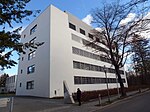Otto-Suhr-Institut
1959 establishments in GermanyBerlin building and structure stubsEducational institutions established in 1959Free University of BerlinGermany university stubs ... and 2 more
Political research institutesPolitical science in Germany

The Otto-Suhr-Institut für Politikwissenschaft (Otto Suhr Institute for Political Science, also OSI) is a research institute of the Free University of Berlin and one of the leading political science institutions in Germany. It is named after Otto Suhr (1894–1957, SPD), a former mayor of Berlin. The Otto Suhr Institute's political science program is consistently ranked as the top program in Germany and among the top 5 in Europe. It is part of Free University's department of Political and Social Science.
Excerpt from the Wikipedia article Otto-Suhr-Institut (License: CC BY-SA 3.0, Authors, Images).Otto-Suhr-Institut
Von-Laue-Straße, Berlin Dahlem
Geographical coordinates (GPS) Address Nearby Places Show on map
Geographical coordinates (GPS)
| Latitude | Longitude |
|---|---|
| N 52.449 ° | E 13.277 ° |
Address
Freie Universität Berlin
Von-Laue-Straße
14195 Berlin, Dahlem
Germany
Open on Google Maps









